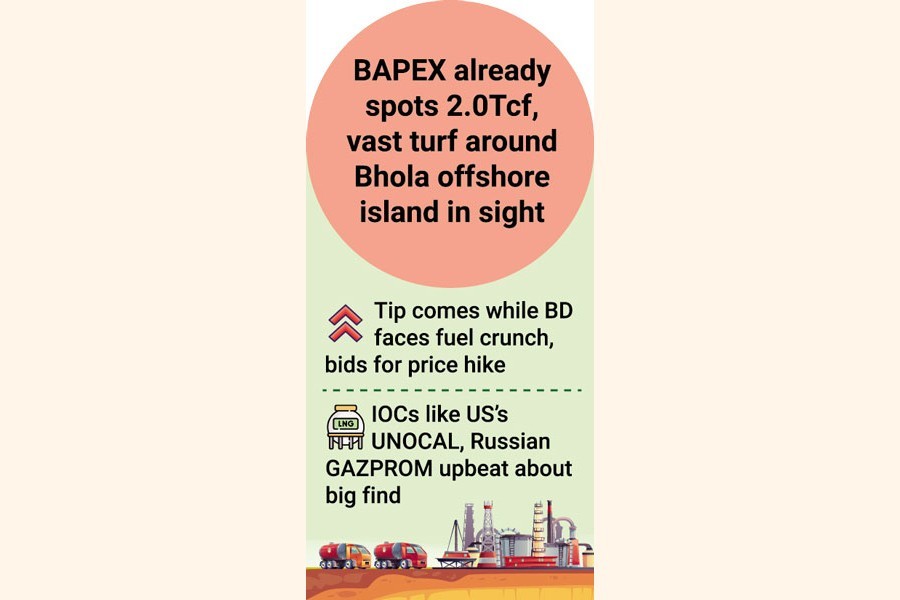Bangladesh may see a change of fortune with prospective huge gas strike in and around offshore Bhola island while the country reels from fuel crunch and expensive LNG import.
In the meantime, state-run Bangladesh Petroleum Exploration and Production Company Ltd (BAPEX) has already discovered two gas fields in Shahbazpur and Bhola North areas that have cumulative recoverable reserves of around 1.5 -2.0 trillion cubic feet (Tcf).
But further upscale reserve growth in Bhola is possible if additional appraisal wells and exploratory wells are drilled in the bay island located in the country's southern part.
A number of international oil companies (IOCs), including US's UNOCAL and Russian GAZPROM, are learnt to be upbeat about hitting the jackpot in Bhola hydrocarbon turfs.
Energy experts also see Bhola as a prospective gas 'trough' after Sylhet 'trough' and seek extensive exploration programmes there to delineate new reserves.
Sylhet trough is already well-explored with the discovery of a total of eight gas fields, including the largest natural gas-producing Bibiyana field, and their accumulative output is around 1,488 million cubic feet per day (mmcfd), or around 64.58 per cent of the country's total gas output of around 2,304 mmcfd from local gas fields, as on February 10, 2022, according to Petrobangla statistics.
Currently, Bhola's gas is 'stranded' within the island with a couple of power plants, including one three-year rental, generating around 260 megawatts of electricity in total.
Shahbazpur gas field is supplying 64mmcfd gas, while Bhola North has yet to initiate supply.
Shahbazpur's gas is more than enough to meet the demand of the two power plants and some local gas-guzzling industries inside the island, said sources.
"The government should carry out extensive natural gas exploration in Bhola and its adjoining areas," says energy-expert Prof Dr Badrul Imam of Geology Department of Dhaka University.
Bhola gas trough, which encompasses Hatiya, Char Fashion and some adjoining areas, holds huge gas-reserve prospect, he adds.
"The BAPEX should carry out the exploration programmes of its own in Bhola," the geologist says.
The state-owned oil-and-gas exploration company can hire some international drilling companies like that of Russian Gazprom to drill wells there, if the BAPEX lacks manpower and necessary drilling equipment, including rigs, he suggests.
Mr Imam, however, opines that the contract price with Gazprom to drill three new wells in Bhola is higher.
The Russian firm obtained contract to drill three wells-Tabgi-1, Bhola North-2 and Illisha-1 -- at a total cost of around US$77.18 million (Tk 6.48 billion).
But BAPEX could carry out the three well drillings at less than half Gazprom's cost, he says.
The government should build a pipeline to carry Bhola gas into mainland for utilization, he opines.
Professor M Tamim, however, suggests assessing Bhola's actual gas reserves before building any transmission pipeline.
"If a significant gas reserves is found, building a pipeline will be feasible," he says. Otherwise, Bhola gas can be utilized to generate electricity there and transmit the electricity into mainland.
Setting up an electricity-transmission line will be cheaper compared to building a gas-transmission pipeline, he views.
Sources say after the discovery of first gas field -Shahbazpur - by BAPEX in 1996 US oil major UNOCAL placed a US$ 700 million proposal named 'Western Region Integrated Project (WRIP) for developing Shahbazpur gas field, construction of 120-kilometre Shahbajpur (Bhola)-Digholia (Khulna) gas pipeline, setting up gas-based power plants in Bhola, Barisal and Khulna.
The proposal was turned down then.
Regarding Bhola gas, Russia's Gazprom country representative in Bangladesh Nikita Shut had in 2018 said that there was a possibility that the volume of gas reserves in place might far outstrip the current estimate.
"If this assumption is confirmed, the Bhola gas field would be bigger than either the Titas or Bibiyana gas field," he added.
He suggested taking more drilling programmes in Bhola in the shortest possible time to estimate the size of the structure and the potential gas reserves.
The government has already planned to carry out more drilling to delineate new gas in Bhola and its adjoining areas, BAPEX managing director Mohammad Ali told the FE Thursday.
The BAPEX will carry out extensive 3D (three-dimensional) and 2D (two-dimensional) seismic survey in and around Bhola island, including Barisal, Muladi in blocks 7 and 10, to find new gas structures, he said.
"Extensive exploration programmes will be taken if significant gas structures could be located," he adds.


